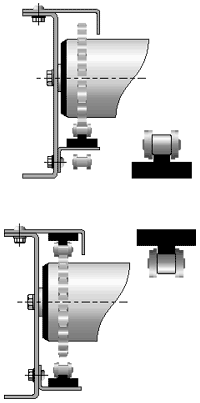 |
Tangential drive The tangential drive (by chain) is characterised by a good level of efficiency and simple design. The installation length of the roller is shorter than for a drive from roller to roller. A single chain drives all the rollers of the conveyor. The chain is pressed onto the appropriate sprocket by the chain guide profile made of special UHMW polyethylene. The roller teeth meshing with the chain only transfer the driving power necessary for the individual roller. The chain can be guided either along the top or bottom of the rollers. The chain guide in relation to the roller has to be positioned accurately (to within 0.5 mm). The motor station to be used is installed in such a way that the pulling side of the chain is as short as possible. The motor station is usually also provided with a device for adjusting chain tension. Tension rollers, which have to bear not only the load of the items being conveyed but also the forces of chain traction, may have to be checked especially with regard to their maximum roller load. The conveyor length to be driven by a drive unit is only restricted by the maximum breaking load of the chain and the weight of the payload. With the tangential drive, roller spacing (roller pitch) can be selected as required. Compared with driving from roller to roller, rollers are easy to remove and fit. | ||||||||||||||||||||||||||||||||
 |
Roller-to-roller drive (chain) Here too, the design is simple, but there are a few design limitations when using this type of drive. No chain guide is required, but the roller pitch (distance from roller to roller) depends on the size of the chain, and close tolerances must be maintained (see Tolerances table). The maximum conveyor length that can be driven by one motor is restricted by the maximum breaking load of the chain; the chain experiences maximum load at the motor station. The drive station should, therefore, always be positioned at the centre of the conveyor length in order to take full advantage of the permissible tractive forces of the chain. When designing the drive station, care must be taken to ensure that the sprockets have a 180° deflection if possible and the chain can be retensioned. |
||||||||||||||||||||||||||||||||
 |
Chinabase suggests the following tolerances for roller spacing t:
|
||||||||||||||||||||||||||||||||
 |
Toothed belt (timing belt) As an alternative to the roller-to-roller chain drive it is also possible to use a toothed belt (i.e. a timing belt). Toothed belt drives run quietly, are maintenance- free and can be used at high drive speeds. As with the chain drive, roller pitch has to be within close limits. The tolerance for roller pitch t is 0 to -0.3 mm using Chinabase special toothed belts. |